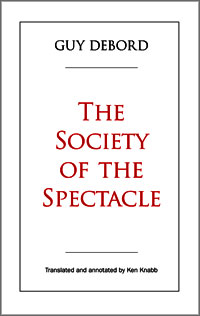The Society of the Spectacle
(Ken Knabb’s New Annotated Translation of the book by Guy Debord)

1. Separation Perfected
2. The Commodity as Spectacle
3. Unity and Division Within Appearances
4. The Proletariat as Subject and Representation
5. Time and History
6. Spectacular Time
7. Territorial Management
8. Negation and Consumption Within Culture
9. Ideology Materialized
Preface
The first version of this translation of
The Society of the Spectacle
was completed and posted online at my “Bureau
of Public Secrets” website in 2002. The first print
version was published by Rebel Press (London) in 2004 and several other
editions were subsequently published in various print and digital formats. Meanwhile
I continued to fine-tune the version on my website. Although I will continue to tweak the online version as
further improvements occur to me, this new printed edition is probably pretty close to final.
There have been several previous English translations of Debord’s book. I have gone through them all and have retained whatever seemed already to be adequate. In particular, I have adopted quite a few of Donald Nicholson-Smith’s renderings, though I have diverged from him in many other cases. His translation (Zone Books, 1994) and the earlier one by Fredy Perlman and friends (Black and Red, 1970; revised 1977; reprinted by AK Press, 2005) are both still in print, and both can also be found at various online sites. Although I obviously would not have taken the trouble to do this new translation if I had not felt there was room for improvements in those earlier translations, I encourage readers to compare all three versions in order to get a fuller sense of the original text. In many cases the differences are matters of stylistic nuances and it may be debatable which phrasing conveys Debord’s meaning most clearly and accurately.
Regardless of such differences, I am pleased to note that my good friends Lorraine Perlman (Fredy’s widow) and Donald Nicholson-Smith have graciously expressed enthusiastic support for the idea of providing annotations.
Many people have told me that they became discouraged by the opening pages of the book and gave up. If this is the case with you, I suggest that you try starting with one of the later chapters. If you have some familiarity with radical politics, try chapter 4. As you see how Debord deals with particular movements and events of modern history, you may get a better idea of the practical implications of ideas that are presented more abstractly in the first three chapters. If you are more familiar with earlier history, or with urban social issues, or with art and culture, you might instead try starting with chapter 5 or 7 or 8.
The book is not, however, as difficult or abstract as it is reputed to be. It is not an ivory-tower “philosophical” dissertation. Nor, as others have sometimes imagined, is it a mere expression of “protest.” It is a carefully considered effort to clarify the most fundamental tendencies and contradictions of the society in which we find ourselves and to point out the advantages and drawbacks of various methods for changing it. Every single thesis has a direct or indirect bearing on issues that are matters of life and death. Chapter 4, which with remarkable conciseness sums up the key lessons of two centuries of revolutionary experience, is simply the most obvious example.
As I noted in The Joy of Revolution:
Much of the situationists’ impact stemmed from the fact that they articulated things that most people had already experienced but were unable or afraid to express until someone else broke the ice. (“Our ideas are in everybody’s mind.”) If some situationist texts nevertheless seem difficult at first, this is because their dialectical structure goes against the grain of our conditioning. When this conditioning is broken they don’t seem so obscure (they were the source of some of the most popular May 1968 graffiti). Many academic spectators have floundered around trying unsuccessfully to resolve the various “contradictory” descriptions of the spectacle in The Society of the Spectacle into some single, “scientifically consistent” definition; but anyone engaged in contesting this society will find Debord’s examination of it from different angles eminently clear and useful, and come to appreciate the fact that he never wastes a word in academic inanities or pointless expressions of outrage.
In short, you can really understand this book only by using it. This makes it more of a challenge, but it is also why it remains so pertinent nearly half a century after its original publication while countless other social theories and intellectual fads have come and gone.
It has, in fact, become even more pertinent than ever, because the spectacle has become more all-pervading than ever — to the point that it is almost universally taken for granted. Most people today have scarcely any awareness of pre-spectacle history, let alone of anti-spectacle possibilities. As Debord noted in his follow-up work, Comments on the Society of the Spectacle (1988), “spectacular domination has succeeded in raising an entire generation molded to its laws.”
I hope this new edition helps you break out of that mold.
—KK, 2014
Note for the 2024 edition:
For this new edition I have made some minor stylistic revisions to the translation and added a few more notes.
Thanks to the folks at PM Press for their enthusiastic collaboration, and special thanks to Jeanne Smith for her superb design work and extensive technical assistance.
—KK, 2024
Contents and Preface of Ken Knabb’s annotated translation of Guy Debord’s book The Society of the Spectacle (Bureau of Public Secrets, 2014; PM Press, 2024).
More information on the annotated edition
Texts of related interest at this website:
Situationist
International Anthology (revised and expanded edition: PM Press, 2024)
Writings on Art and Architecture (Jorn, 1954-1958)
Guy Debord’s Films
(1952-1978)
The Power of Negative Thinking (Chasse, 1968)
Total Self-Management (Vaneigem, 1974)